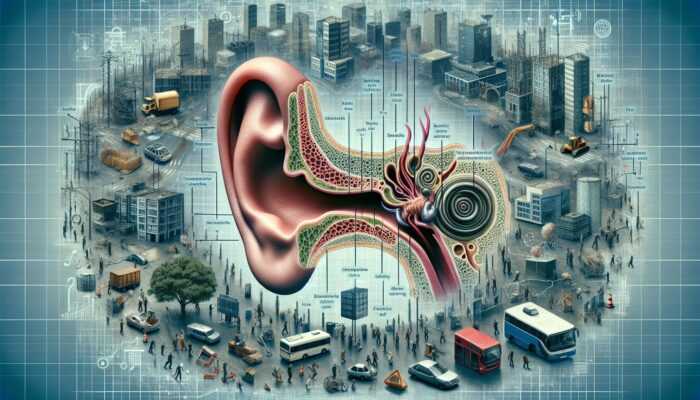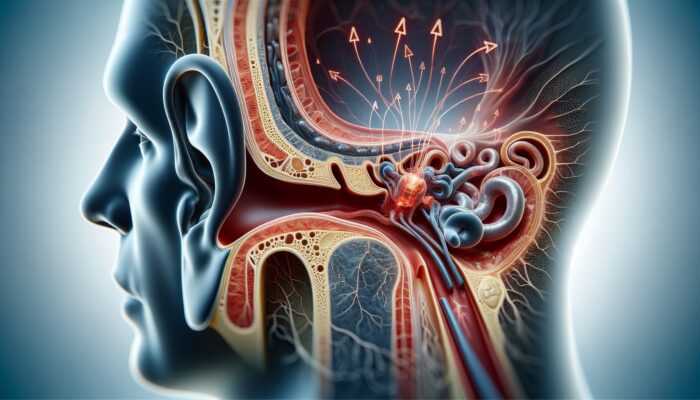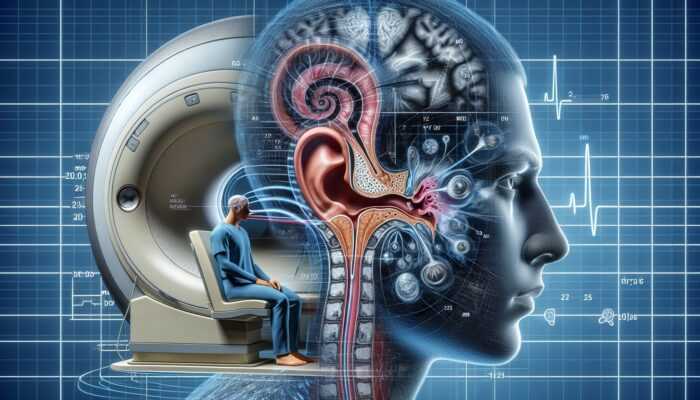Last Updated on 21/05/2025 by Admin
Comprehensive Insights into Tinnitus and Its Management
tinnitus is a complex condition that manifests as the perception of sound, often described as ringing, buzzing, hissing, or clicking in the ears, affecting millions of people worldwide. For those who suffer from it, this condition can significantly impact daily life, with the perceived sound varying from a soft whisper to a deafening roar. Imagine attempting to hold a conversation or savor a moment of silence, only to be interrupted by an unrelenting noise that is not audible to others. This is the everyday reality for many individuals grappling with Tinnitus. Understanding this condition is crucial for developing effective management strategies and improving the quality of life for those affected.
Recognizing and understanding the symptoms of tinnitus is vital for both patients and healthcare professionals. Common symptoms include difficulties with concentration, sleep disturbances, and heightened levels of anxiety, all of which can drastically reduce one’s quality of life. Many individuals find that the persistent sound interferes with their daily activities, making even simple tasks more challenging. Current statistics indicate that approximately 15% to 20% of adults encounter some form of tinnitus, highlighting its widespread nature. Importantly, tinnitus does not discriminate; it can impact anyone, irrespective of age, gender, or background.
Tinnitus is primarily divided into two categories: subjective and objective. Subjective tinnitus is the more prevalent type, where only the individual perceives the sound, often linked to physiological changes in the auditory system, typically due to hearing loss or damage. In contrast, objective tinnitus is rare and can be detected by a clinician using specialized tests, potentially pointing to underlying medical conditions such as vascular abnormalities or muscle spasms. Understanding these types is essential for proper diagnosis and tailored treatment approaches.
The effects of tinnitus extend far beyond mere auditory disturbances. Individuals often report experiencing significant mental health challenges, including depression and anxiety, as a direct consequence of their condition. The frustration of not being understood, coupled with the fear of potential hearing loss, can lead to a downward spiral of stress and emotional distress. On a broader scale, the burden of tinnitus transcends individual experiences, affecting families, workplaces, and communities, emphasizing the urgent need for more effective understanding and management strategies.
Defining Tinnitus and Recognizing Its Symptoms
Tinnitus is an intricate auditory phenomenon that goes beyond merely hearing sound; it encompasses a wide range of experiences. While often characterized as ringing, the reality for those affected is more multifaceted, including sounds like buzzing, hissing, roaring, or chirping. This variability creates a unique challenge for each individual, as their experience is shaped by personal auditory systems and external environmental factors. In certain situations, the sound may be a constant background noise, interfering with daily activities and mental focus, while at other times it may be intermittent, flaring up during periods of stress or following exposure to loud sounds.
The manifestations of tinnitus can vary greatly, leading to significant disruptions in daily living. Many sufferers report difficulties in concentrating, as the continuous noise competes for attention against other auditory stimuli. Sleep disturbances are another prevalent issue, as the noise can hinder both the ability to fall asleep and stay asleep, resulting in fatigue and diminished cognitive function during daytime hours. Furthermore, the emotional toll of living with tinnitus can be severe, with numerous individuals experiencing heightened anxiety or depression while grappling with the unpredictable nature and intensity of their symptoms.
Understanding the various symptoms of tinnitus is essential for effective management and treatment. For some, the sound may be barely perceptible, allowing for a relatively normal life, whereas for others, it can be debilitating. This broad spectrum of experiences highlights the necessity for personalized approaches to treatment and coping strategies. Healthcare professionals often recommend that patients keep a journal to track their tinnitus symptoms, which can assist in identifying potential triggers and patterns. This information is invaluable for developing a tailored management plan that caters to the individual’s unique needs.
In summary, tinnitus is a complex condition that can profoundly affect an individual’s quality of life. The diverse range of symptoms necessitates a nuanced understanding and tailored management approaches. By acknowledging the complexities of tinnitus, individuals and healthcare providers can collaborate to identify effective coping strategies, ultimately leading to an enhanced quality of life for those affected by this condition.
Exploring the Types of Tinnitus
Investigating the different types of tinnitus reveals a fascinating yet intricate aspect of this auditory condition. Tinnitus is primarily categorized into two main types: subjective and objective. Subjective tinnitus is the most prevalent form, impacting a significant majority of individuals. In this type, the sounds are experienced solely by the person, making it inherently challenging to diagnose and treat. The subjective nature of this form necessitates that healthcare providers heavily rely on patient accounts to understand the severity and implications of the condition.
On the other hand, objective tinnitus, although rarer, can be detected by healthcare professionals during examinations. This type may be associated with specific health conditions, such as vascular issues or muscle spasms, producing audible sounds that can be heard using specialized medical equipment. The presence of objective tinnitus often necessitates further investigation to determine the underlying cause, making it a more straightforward issue to address in certain cases.
The implications of these types extend beyond mere classification; they significantly influence the management strategies employed by healthcare providers. Subjective tinnitus typically requires a combination of lifestyle modifications and therapeutic interventions, given its strong links to psychological and auditory factors. Conversely, objective tinnitus may call for more immediate medical interventions to address the underlying conditions causing the sound, which may include surgical options or medication.
Recognizing the different types of tinnitus is crucial for both sufferers and healthcare providers. This understanding allows for a more customized approach to treatment, enhancing the likelihood of symptom relief and improved quality of life. Additionally, acknowledging the diverse experiences of tinnitus helps validate the challenges faced by individuals living with the condition, reinforcing the need for compassionate, patient-centered care that considers the unique hurdles posed by each type of tinnitus.
Ultimately, categorizing tinnitus into subjective and objective forms provides a framework for comprehending this multifaceted condition. By identifying the distinct characteristics of each type, healthcare professionals can devise more effective management strategies, ultimately leading to improved outcomes for those dealing with tinnitus.
Understanding the Prevalence and Broader Impact of Tinnitus
Tinnitus affects a substantial segment of the global population, with estimates indicating that between 15% and 20% of adults experience some degree of tinnitus at various points in their lives. This prevalence underscores the condition’s commonality, rendering it a public health issue that necessitates attention. Interestingly, experiences of tinnitus are not uniform; they differ widely among individuals due to factors such as age, gender, and overall health status.
The impacts of tinnitus go beyond auditory symptoms. Many individuals report that tinnitus adversely affects their overall quality of life, hindering their ability to concentrate, sleep, and engage in social interactions. This multifaceted impact can lead to a range of psychological challenges, including heightened anxiety, depression, and feelings of isolation. As individuals struggle to cope with the persistent noise, it creates a ripple effect that alters their interactions with family, friends, and colleagues. This social and emotional toll highlights the necessity for comprehensive management strategies that address both the physical and psychological dimensions of tinnitus.
Research suggests that the effects of tinnitus can vary across demographic groups. For instance, older adults are more likely to experience age-related hearing loss, which can exacerbate the severity of tinnitus symptoms. Conversely, younger individuals may develop tinnitus due to exposure to loud music or environments. This demographic disparity emphasizes the importance of targeted prevention and intervention strategies tailored to specific age groups and risk factors.
The global community is becoming increasingly aware of tinnitus as a significant health concern. Advocacy groups and awareness campaigns are actively working to educate the public about the condition, its causes, and potential management strategies. Educational resources are being developed across the globe to empower individuals with the knowledge they need to comprehend and navigate their tinnitus experiences. This growing awareness is essential for fostering a supportive environment for those affected by tinnitus and encouraging dialogue around effective coping mechanisms and treatment options.
Ultimately, the prevalence and impact of tinnitus are substantial, affecting not only individuals but also families and communities on a global scale. By addressing the multifaceted nature of tinnitus, healthcare providers and policymakers can work together to develop more effective strategies for prevention, diagnosis, and management, thereby improving the quality of life for those challenged by this condition.
Identifying Common Causes of Tinnitus
While many associate tinnitus primarily with hearing loss, numerous factors contribute to this multifaceted condition. Understanding the underlying causes is crucial for effective management and prevention strategies. Among the most frequent causes of tinnitus are exposure to loud noise, age-related hearing loss, as well as various medical conditions and medications. These factors not only highlight the intricate nature of tinnitus but also underscore the necessity for tailored treatment approaches.
The Role of Loud Noise Exposure in Tinnitus Development
Exposure to loud noise is a leading contributor to the onset of tinnitus, making it a significant concern in today’s sound-dominated world. Prolonged exposure to high-decibel environments, such as construction sites, live concerts, or even listening to music at elevated volumes through earbuds, can damage the delicate hair cells in the inner ear. Once these cells are compromised, the brain may misinterpret signals, resulting in the perception of sounds that are absent from the external environment—this encapsulates the essence of tinnitus.
Research indicates that even brief exposure to loud sounds can lead to temporary or permanent auditory changes, laying the groundwork for tinnitus development. For example, studies demonstrate that individuals working in noisy occupations, such as musicians or factory workers, face a heightened risk of developing tinnitus. This underscores the importance of protective measures, such as using earplugs or noise-canceling headphones, to mitigate the risk of auditory damage.
The global implications of noise-induced tinnitus are staggering. According to the World Health Organization, roughly 1.1 billion adolescents and young adults are at risk of hearing loss due to unsafe listening practices. This alarming statistic highlights the urgent need for awareness and education regarding safe listening habits to prevent the onset of tinnitus. Communities worldwide are beginning to acknowledge the significance of sound management, implementing programs that promote responsible noise exposure, especially among younger populations.
Moreover, the psychological ramifications of living with noise-induced tinnitus cannot be underestimated. The constant ringing or buzzing can lead to frustration, anxiety, and feelings of isolation. Individuals may withdraw from social situations, fearing that the noise will disrupt conversations or activities. This psychological burden adds another layer to the challenge of managing tinnitus, necessitating a holistic approach that combines auditory protection with mental health support.
In conclusion, awareness of the risks associated with exposure to loud noise is critical for preventing tinnitus. Communities and individuals must prioritize sound management strategies to protect their auditory health. By fostering a culture of safe listening, we can significantly decrease the incidence of tinnitus, thereby improving the overall quality of life for those affected by this condition.
The Impact of Age-Related Hearing Loss on Tinnitus
As people age, the natural deterioration of the auditory system becomes increasingly evident, often leading to age-related hearing loss. This physiological decline is one of the most common causes of tinnitus, particularly among the elderly. Research suggests that nearly one-third of adults aged 65 to 74 experience significant hearing loss, with the incidence rising to nearly half for those aged 75 and older. The correlation between age-related hearing loss and tinnitus is evident, as the loss of auditory input can trigger the brain to generate phantom sounds, resulting in the perception of tinnitus.
The mechanisms underpinning age-related hearing loss are complex and multifaceted. Over time, the hair cells in the inner ear gradually become damaged or lost, diminishing the ability to detect sound. This reduction in auditory input may provoke compensatory responses from the brain, manifesting as tinnitus. The brain’s attempt to fill the auditory void can create a constant perception of sound, leading to the distressing experience of tinnitus for many older adults.
In addition to the physical changes associated with aging, the emotional and social implications of tinnitus can be profound. Older adults may find it increasingly difficult to engage in conversations, resulting in feelings of frustration and social withdrawal. The combination of hearing loss and tinnitus can create a debilitating cycle—where the inability to hear prompts the brain to generate tinnitus, which further isolates the individual from social interactions. This cycle can significantly impact mental health, contributing to increased feelings of loneliness and depression.
Effectively managing age-related tinnitus requires a comprehensive approach. Regular hearing assessments are essential for identifying changes in auditory function, allowing for early intervention. Hearing aids can be a valuable tool for those experiencing hearing loss, as they help amplify sound and improve communication. By enhancing auditory input, individuals may find some relief from tinnitus symptoms, leading to an improved quality of life.
In addition to hearing aids, lifestyle modifications can play a significant role in managing age-related tinnitus. Engaging in social activities, practicing relaxation techniques, and maintaining a nutritious diet can help mitigate the emotional impact of tinnitus. Support groups can also provide a valuable space for sharing experiences and coping strategies among individuals facing similar challenges.
In summary, age-related hearing loss serves as a significant contributor to tinnitus, particularly among older adults. A proactive approach to hearing health, including regular assessments and the use of hearing aids, can help mitigate the effects of tinnitus and improve overall well-being. By addressing both the physical and emotional aspects of this condition, we can enhance the quality of life for those affected by age-related tinnitus.
The Connection Between Medical Conditions, Medications, and Tinnitus
Tinnitus can also arise from a variety of medical conditions and medications, illustrating its complexity as a symptom rather than a standalone disorder. Specific health issues, such as Meniere’s disease, acoustic neuroma, or even cardiovascular conditions, can lead to the development of tinnitus. These underlying medical factors create a compelling need for thorough evaluations to determine the root cause of the symptoms.
Meniere’s disease, for instance, is characterized by fluid accumulation in the inner ear, resulting in fluctuating hearing loss, vertigo, and tinnitus. Individuals affected by this condition often report a debilitating cycle of auditory and vestibular disturbances, making it challenging to manage their daily lives. Effective treatment for Meniere’s disease often involves a combination of dietary changes, medications, and, in some cases, surgical interventions to alleviate the symptoms.
Similarly, certain medications can contribute to tinnitus as a side effect. Known as ototoxic medications, these include specific antibiotics, chemotherapy agents, and high doses of aspirin. The risk of developing tinnitus from these medications varies among individuals, depending on factors such as dosage, duration of use, and personal susceptibility. It’s essential for individuals to communicate with their healthcare providers about any existing conditions or medications that may be exacerbating their tinnitus symptoms.
The importance of a comprehensive medical evaluation cannot be overstated when diagnosing and managing tinnitus. Healthcare providers typically begin with a detailed medical history and physical examination to identify potential causes. Audiological assessments, including hearing tests, can help determine if hearing loss is a contributing factor. In some cases, imaging studies such as MRI or CT scans may be necessary to rule out more serious underlying issues, such as tumors or vascular problems.
Addressing the medical causes of tinnitus requires a collaborative approach between patients and healthcare providers. A thorough understanding of the individual’s medical history, current medications, and lifestyle can inform treatment strategies. In cases where tinnitus is linked to a specific medical condition, targeted interventions may help alleviate symptoms and improve overall quality of life.
In conclusion, the relationship between medical conditions, medications, and tinnitus is intricate and multifaceted. By recognizing the various factors that contribute to tinnitus, healthcare providers can develop tailored management plans that address both the auditory symptoms and underlying health issues. This comprehensive approach can lead to improved outcomes for individuals grappling with the challenges of tinnitus.
Effective Strategies for Diagnosing Tinnitus
Diagnosing tinnitus is a crucial step in formulating an effective management plan; however, the process can often be complex due to the subjective nature of the condition. Healthcare providers typically employ a combination of medical history assessments, physical examinations, and specialized tests to identify potential causes of tinnitus. A thorough understanding of the diagnostic process is essential for individuals seeking relief from their symptoms.
Conducting an Initial Assessment for Tinnitus
The diagnostic journey for tinnitus commences with an initial assessment by a healthcare provider. During this phase, practitioners will conduct a comprehensive medical history review, considering any recent changes in hearing, exposure to loud noises, or existing medical conditions. This dialogue is crucial, as it helps build a clearer picture of the individual’s auditory health and potential contributing factors to their symptoms.
In addition to gathering information about the individual’s medical history, the provider will perform a physical examination, focusing on the ears, head, and neck. This examination aims to identify any visible abnormalities or signs of underlying health issues that may be contributing to tinnitus. For example, conditions such as earwax buildup, infections, or structural abnormalities can often be identified during this physical evaluation.
A thorough initial assessment is critical for determining the next steps in the diagnostic process. It allows healthcare providers to pinpoint potential risk factors and tailor their approach to the individual’s unique situation. For instance, if the assessment indicates a history of loud noise exposure, the provider may prioritize audiological evaluations to assess hearing loss, a common cause of tinnitus.
Ultimately, the initial assessment serves as the foundation for effective diagnosis and management of tinnitus. By taking the time to understand the individual’s medical history and physical condition, healthcare providers can develop a more focused approach to addressing the underlying causes of tinnitus. This comprehensive strategy can lead to more accurate diagnoses and improved outcomes for individuals living with this condition.
Utilizing Hearing Tests in Tinnitus Diagnosis
Following the initial assessment, hearing tests are often conducted to evaluate the extent of auditory function and determine if hearing loss contributes to tinnitus. These audiological evaluations are critical to the diagnostic process and typically include a variety of tests designed to assess different aspects of hearing.
One of the most common tests is pure-tone audiometry, where individuals listen to a series of tones at varying frequencies and intensities. This test helps to map the individual’s hearing thresholds and identify specific frequencies where hearing loss may be present. The results can provide valuable insights into the relationship between hearing loss and tinnitus, guiding subsequent management strategies.
In addition to pure-tone audiometry, other tests may be performed to assess the functionality of the auditory system. Speech audiometry evaluates how well individuals understand speech in various listening environments, while tympanometry assesses the mobility of the eardrum and the middle ear. These tests help to identify any underlying issues that may contribute to tinnitus, such as fluid in the middle ear or other abnormalities.
The results of these hearing tests play a pivotal role in shaping the management plan for individuals with tinnitus. If hearing loss is identified, healthcare providers may recommend interventions such as hearing aids or auditory rehabilitation programs. By improving auditory function, individuals may find some relief from tinnitus symptoms, enhancing their overall quality of life.
In summary, hearing tests are a vital component of the tinnitus diagnostic process. They provide essential information about auditory function and help to establish a clear connection between hearing loss and tinnitus. By utilizing these evaluations, healthcare providers can develop personalized management plans that address the unique needs of individuals living with tinnitus.
Employing Additional Diagnostic Tools for Comprehensive Evaluation
In certain cases, additional diagnostic tools may be utilized to further investigate the underlying causes of tinnitus. While hearing tests and initial assessments are critical, they may not always provide a complete picture of the individual’s auditory health. Therefore, healthcare providers may turn to imaging studies and laboratory tests to rule out potential medical conditions that could be contributing to tinnitus.
Imaging studies, such as magnetic resonance imaging (MRI) or computed tomography (CT) scans, can be instrumental in identifying structural abnormalities within the auditory system. For instance, these scans can help detect tumors, vascular malformations, or other conditions that may be causing tinnitus symptoms. Identifying these underlying issues is crucial, as it can lead to targeted interventions that address the root cause of the tinnitus rather than merely treating the symptoms.
Blood tests may also be conducted to assess overall health and rule out systemic conditions that could be linked to tinnitus. For example, thyroid disorders, autoimmune diseases, and vitamin deficiencies are all factors that can contribute to tinnitus development. By conducting a comprehensive evaluation, healthcare providers can gain a better understanding of the individual’s health status and tailor their management strategies accordingly.
The use of specialized diagnostic tools underscores the complexity of tinnitus as a symptom rather than a standalone condition. It highlights the importance of a multidisciplinary approach to diagnosis and management, bringing together audiologists, otolaryngologists, and primary care providers to collaborate on the best course of action for individuals experiencing tinnitus.
In conclusion, additional diagnostic tools play a crucial role in the comprehensive evaluation of tinnitus. By utilizing imaging studies and laboratory tests, healthcare providers can gain valuable insights into potential underlying causes, leading to more effective and targeted treatment plans for individuals living with this condition.
Assessing Tinnitus Through Questionnaires
To gain a deeper understanding of how tinnitus affects an individual’s daily life, healthcare providers often utilize tinnitus-specific questionnaires. These assessments are designed to evaluate the severity of tinnitus symptoms and their impact on an individual’s quality of life. By gathering this information, practitioners can tailor their management strategies to address the unique challenges faced by each patient.
Tinnitus questionnaires typically include a variety of questions that assess aspects such as the perceived loudness of the tinnitus, its frequency, and the emotional distress it causes. For example, individuals may be asked to rate the intensity of their tinnitus on a scale or describe how often they experience the sound. Additionally, questions may explore how tinnitus affects daily activities, sleep quality, and overall well-being.
The information obtained from these questionnaires is invaluable for developing a comprehensive understanding of each individual’s experience with tinnitus. It allows healthcare providers to identify patterns and trends that may not be apparent through clinical assessments alone. By quantifying the impact of tinnitus on an individual’s life, practitioners can better understand the severity of the condition and prioritize treatment options accordingly.
Moreover, tinnitus-specific questionnaires can serve as a useful tool for tracking changes in symptoms over time. By administering these assessments at regular intervals, healthcare providers can monitor the effectiveness of treatment strategies and make necessary adjustments. This ongoing evaluation helps ensure that individuals receive the most appropriate and effective care for their tinnitus.
In summary, tinnitus-specific questionnaires provide essential insights into the severity and impact of symptoms on an individual’s life. By utilizing these assessments, healthcare providers can develop personalized management plans that address the unique challenges faced by each patient, ultimately improving their quality of life. This patient-centered approach underscores the importance of understanding not just the auditory symptoms of tinnitus, but also the broader effects on emotional and social well-being.
Implementing Lifestyle Modifications for Tinnitus Management
Managing tinnitus often necessitates a multifaceted approach, and lifestyle modifications play a pivotal role in alleviating symptoms. Many individuals discover that by making simple adjustments to their daily routines and habits, they can substantially reduce the impact of tinnitus on their lives. Key lifestyle changes include effective noise management, dietary considerations, and stress reduction techniques. These strategies can help create a more supportive environment for individuals confronting tinnitus, ultimately leading to an enhanced quality of life.
Mastering Noise Management Strategies
In a world filled with sound, managing noise exposure is a fundamental aspect of tinnitus management. For individuals experiencing tinnitus, loud environments can exacerbate symptoms, making it essential to adopt noise management strategies to safeguard auditory health. One of the most effective methods of noise management is the use of ear protection in noisy settings. Earplugs or noise-canceling headphones can help reduce the intensity of sound exposure, preventing further damage to the auditory system and minimizing the perception of tinnitus.
Creating a quieter living environment is another valuable strategy for individuals with tinnitus. This may involve reducing background noise levels at home, such as utilizing soft furnishings that absorb sound or employing white noise machines to provide a soothing auditory backdrop. The use of gentle background noise can help mask the perception of tinnitus, making it less intrusive and allowing individuals to focus on daily tasks without distraction.
In addition to protective measures and environmental adjustments, individuals can also benefit from practicing mindfulness around noise exposure. Being aware of the sounds in one’s environment and actively seeking quieter spaces when possible can help mitigate the impact of tinnitus. For example, taking breaks from loud activities or finding serene outdoor locations can provide respite from overwhelming auditory stimuli.
Moreover, education and awareness about safe listening practices are essential components of noise management. Individuals should be encouraged to adopt responsible habits, such as lowering the volume when using headphones, taking regular breaks from loud environments, and using ear protection when necessary. By prioritizing auditory health, individuals can significantly reduce their risk of developing tinnitus and enhance their overall well-being.
In conclusion, effective noise management is a vital component of tinnitus management. By adopting protective strategies, creating quieter environments, and fostering awareness of safe listening practices, individuals can alleviate the impact of tinnitus and improve their overall quality of life. This proactive approach empowers individuals to take control of their auditory health and navigate their experiences with tinnitus more effectively.
Enhancing Well-Being Through Diet and Nutrition
Diet and nutrition can significantly influence the management of tinnitus symptoms. While ongoing research explores the relationship between specific foods and tinnitus, many individuals report that certain dietary changes help alleviate their symptoms. A balanced diet rich in essential nutrients can support overall health and may reduce the severity of tinnitus for some.
One commonly discussed dietary factor is sodium intake. High sodium consumption has been linked to increased fluid retention, which can exacerbate tinnitus symptoms, particularly for those with Meniere’s disease. Reducing sodium intake by opting for fresh, whole foods and minimizing processed foods can help mitigate this effect. Additionally, maintaining proper hydration by drinking sufficient water supports overall health and can potentially alleviate tinnitus symptoms.
Another dietary consideration is the consumption of caffeine and alcohol. Research suggests that caffeine may worsen tinnitus symptoms in some individuals, leading to an amplified perception of sound. Similarly, alcohol can have a diuretic effect, resulting in dehydration and fluid imbalances that may impact tinnitus. Reducing or eliminating these substances from the diet may help some individuals experience a decrease in symptoms.
Antioxidant-rich foods, such as fruits and vegetables, are also beneficial for overall health and may play a role in managing tinnitus. Nutrients like magnesium, zinc, and vitamins A, C, and E are thought to support auditory health and may help alleviate inflammation in the body. Incorporating a variety of colorful fruits and vegetables into the diet can provide essential vitamins and minerals that contribute to overall well-being.
In addition to specific dietary changes, individuals should be encouraged to adopt a balanced approach to nutrition. Eating regular, well-rounded meals that include sources of protein, healthy fats, and carbohydrates can help stabilize energy levels and support mental well-being. This can be particularly important for individuals coping with the emotional challenges associated with tinnitus.
In summary, while the relationship between diet and tinnitus is complex, many individuals find that dietary modifications can positively impact their symptoms. By prioritizing a balanced diet, reducing sodium and caffeine intake, and incorporating antioxidant-rich foods, individuals can support their overall health and potentially alleviate the impact of tinnitus on their lives. This holistic approach to nutrition empowers individuals to take charge of their well-being and navigate their experiences with tinnitus more effectively.
Implementing Stress Reduction Techniques
Stress is a significant factor that can exacerbate tinnitus symptoms, making stress reduction techniques an essential component of effective management. When individuals are under stress, their bodies may respond with increased sensitivity to sound, amplifying the perception of tinnitus. Therefore, incorporating relaxation practices into daily routines can help mitigate stress and improve overall well-being for those living with tinnitus.
Mindfulness and meditation are powerful tools for managing stress and enhancing emotional resilience. Research has shown that mindfulness practices can help individuals develop a greater awareness of their thoughts and feelings, allowing them to respond to tinnitus with a calm and centered mindset. Techniques such as deep breathing, progressive muscle relaxation, and guided imagery can provide valuable coping strategies for individuals experiencing the distressing sounds of tinnitus.
Physical activity is another effective stress reduction technique that can contribute to overall health and well-being. Engaging in regular exercise releases endorphins, which are natural mood enhancers that can alleviate feelings of anxiety and depression. Activities such as walking, jogging, yoga, or swimming can provide a welcome distraction from tinnitus symptoms and foster a sense of accomplishment and well-being.
Social support is equally important for managing stress. Connecting with friends, family, or support groups can provide individuals with valuable emotional outlets and reassurance. Sharing experiences with others who understand the challenges of living with tinnitus can foster a sense of community and reduce feelings of isolation. Engaging in social activities can also serve as a positive distraction from the constant sounds of tinnitus.
In conclusion, stress reduction techniques are essential for effectively managing tinnitus. By incorporating mindfulness practices, regular physical activity, and social support into daily routines, individuals can enhance their ability to cope with the challenges of tinnitus. This holistic approach empowers individuals to take control of their well-being and navigate their experiences with tinnitus in a more positive light.
Exploring Therapeutic Approaches for Tinnitus Management
As our understanding of tinnitus continues to evolve, various therapeutic approaches have emerged to help individuals manage their symptoms more effectively. Among these, sound therapy, cognitive behavioral therapy (CBT), and tinnitus retraining therapy (TRT) have gained recognition as effective options. Each of these approaches offers unique benefits and can be tailored to meet the specific needs of individuals experiencing tinnitus.
Utilizing Sound Therapy for Tinnitus Relief
Sound therapy is a prominent method for managing tinnitus that involves the use of external sounds to mask or distract from the perception of tinnitus. The principle behind sound therapy is straightforward: by introducing external sounds into the environment, individuals can redirect their focus away from the internal sounds of tinnitus, making them less intrusive and distressing.
A variety of sound therapy options are available, ranging from white noise machines to nature sounds or even music. For instance, white noise can effectively cover the ringing or buzzing associated with tinnitus, providing a soothing backdrop that can promote relaxation and improve focus. Many individuals find that listening to calming sounds—such as ocean waves, rain, or birds chirping—can create a peaceful environment that helps alleviate the perception of tinnitus.
The use of sound therapy is particularly beneficial during quiet moments, such as at bedtime or when engaged in activities requiring concentration. For individuals who struggle with sleep disturbances due to tinnitus, sound therapy can serve as a valuable tool for creating a calming auditory environment conducive to relaxation. Some people even utilize sound apps on their smartphones, allowing them to customize their listening experiences and find the sounds that work best for them.
Moreover, combining sound therapy with other therapeutic approaches can enhance its effectiveness. For example, integrating sound therapy into mindfulness practices or relaxation techniques can amplify the positive effects of both strategies. This integrated approach encourages individuals to actively engage with their auditory environment, fostering a sense of empowerment over their tinnitus symptoms.
In conclusion, sound therapy offers a practical and effective method for managing tinnitus. By introducing external sounds to mask or distract from the internal noise of tinnitus, individuals can create a more supportive auditory environment. This technique not only helps reduce the perception of tinnitus but also promotes relaxation and enhances overall well-being.
Cognitive Behavioral Therapy: A Beneficial Approach for Tinnitus
Cognitive behavioral therapy (CBT) has emerged as a powerful therapeutic approach for individuals dealing with tinnitus. This evidence-based treatment focuses on the relationship between thoughts, emotions, and behaviors, helping individuals reframe their perceptions of tinnitus and develop effective coping strategies. CBT aims to reduce the emotional distress associated with tinnitus, ultimately enhancing overall quality of life.
The core principle of CBT is that negative thoughts and beliefs about tinnitus can contribute to increased anxiety and discomfort. Through CBT, individuals learn to identify and challenge these unhelpful thoughts, replacing them with more constructive and realistic perspectives. For example, rather than viewing tinnitus as an unbearable burden, individuals may come to see it as a manageable aspect of their experience, empowering them to take control of their responses.
CBT also equips individuals with valuable coping skills to manage the emotional challenges of living with tinnitus. Techniques such as relaxation exercises, mindfulness practices, and positive imagery can help individuals develop a greater sense of calm and resilience. By training their minds to respond differently to tinnitus, individuals often report decreased distress and increased emotional well-being.
Research has shown that CBT can be particularly effective for individuals with tinnitus, especially those experiencing significant emotional distress or anxiety. Studies indicate that participants undergoing CBT for tinnitus often report substantial improvements in their ability to cope and a reduction in the perceived severity of their symptoms. This evidence underscores the potential of CBT as a viable therapeutic option for individuals seeking relief from tinnitus.
In summary, cognitive behavioral therapy offers a valuable approach for managing the emotional impact of tinnitus. By reframing negative thoughts and developing effective coping strategies, individuals can enhance their ability to navigate the challenges of tinnitus. This therapeutic approach empowers individuals to take control of their experiences, leading to improved quality of life and emotional well-being.
Tinnitus Retraining Therapy: A Comprehensive Management Strategy
Tinnitus retraining therapy (TRT) is a specialized approach that combines sound therapy with counseling to help individuals habituate to the perception of tinnitus. The underlying principle of TRT is that through consistent exposure to sound and cognitive restructuring, individuals can gradually reduce their awareness of tinnitus, ultimately achieving a state of habituation where the sound becomes less intrusive.
The TRT process typically begins with an initial assessment conducted by a trained professional who evaluates the individual’s tinnitus characteristics and emotional responses. Based on this assessment, a tailored treatment plan is developed, incorporating both sound therapy and counseling components. The counseling aspect of TRT focuses on educating individuals about tinnitus, addressing misconceptions, and promoting a better understanding of the condition.
During the sound therapy phase of TRT, individuals are exposed to low-level background sounds designed to mask or blend with their tinnitus. This exposure helps shift the brain’s focus away from the internal sound, facilitating habituation over time. The goal is to teach the brain to perceive tinnitus as a neutral sound rather than a source of distress.
TRT typically involves a commitment to long-term treatment, often spanning several months to years. This extended timeframe allows individuals to gradually adjust their perceptions and responses to tinnitus, fostering a sense of control over their experiences. Many individuals who undergo TRT report significant reductions in their awareness of tinnitus and improvements in their overall quality of life.
In conclusion, tinnitus retraining therapy offers a comprehensive approach to managing tinnitus that combines sound therapy and counseling. By promoting habituation and addressing emotional responses to tinnitus, individuals can enhance their ability to cope with this challenging condition. This therapeutic approach empowers individuals to reclaim a sense of normalcy in their lives, ultimately leading to improved well-being.
Exploring Medical Interventions for Tinnitus Relief
For some individuals, medical interventions may be necessary to address the symptoms of tinnitus and improve overall quality of life. These interventions can range from medications to hearing aids and, in rare cases, surgical options. Understanding the available medical treatments is essential for individuals seeking relief from their tinnitus symptoms.
Medications: A Supportive Role in Tinnitus Management
Medications can play a valuable role in managing tinnitus symptoms, particularly for individuals experiencing significant emotional distress or anxiety related to their condition. While no specific medication is designed to cure tinnitus, certain drugs may help alleviate the perception of sound or address associated symptoms. For instance, some antidepressants and anti-anxiety medications have been shown to provide relief for individuals with tinnitus.
Antidepressants, such as amitriptyline or nortriptyline, are sometimes prescribed to help reduce the emotional distress associated with tinnitus. By addressing underlying anxiety or depression, these medications can improve overall well-being and enhance coping strategies. Anti-anxiety medications, such as benzodiazepines, may also be prescribed on a short-term basis to help individuals manage acute episodes of anxiety related to tinnitus.
It’s important to note that the use of medications should be carefully monitored by healthcare providers, as individual responses can vary. Additionally, some medications may have potential side effects that could exacerbate tinnitus symptoms. Therefore, open communication with healthcare providers is crucial to ensure that the chosen medications align with the individual’s unique needs and circumstances.
In conclusion, while medications are not a cure for tinnitus, they can provide valuable support for individuals experiencing emotional distress or anxiety related to their condition. By working closely with healthcare providers, individuals can explore medication options that may help alleviate their symptoms and enhance their overall quality of life.
The Role of Hearing Aids in Tinnitus Management
For individuals experiencing tinnitus in conjunction with hearing loss, hearing aids can serve as an effective medical intervention. These devices amplify external sounds, improving auditory input and reducing the perception of tinnitus. By enhancing hearing capabilities, individuals may find that their awareness of tinnitus diminishes, leading to an overall improvement in quality of life.
Hearing aids come in various styles and technologies, allowing for personalized fitting based on individual needs and preferences. Many modern hearing aids are equipped with advanced features, such as noise reduction and sound processing, that can further enhance the listening experience. Some devices even include built-in sound therapy options, providing users with the ability to mask or blend their tinnitus with soothing background sounds.
The use of hearing aids can also have profound social and emotional benefits for individuals with tinnitus. By improving communication abilities, individuals may feel more confident engaging in social situations, reducing feelings of isolation or frustration associated with tinnitus. The act of actively participating in conversations can provide valuable distractions from the perception of tinnitus, enhancing overall well-being.
It’s important for individuals considering hearing aids to undergo comprehensive audiological evaluations to determine the extent of their hearing loss. This evaluation ensures that the selected hearing aids are appropriately fitted and calibrated to address their unique auditory needs. Regular follow-ups with audiologists can help optimize the performance of hearing aids and ensure that individuals receive ongoing support.
In summary, hearing aids represent a valuable medical intervention for individuals experiencing tinnitus alongside hearing loss. By enhancing auditory input and improving communication abilities, hearing aids can significantly alleviate the perception of tinnitus and enhance overall quality of life. Through personalized fitting and ongoing support, individuals can navigate the challenges of tinnitus more effectively.
Considering Surgical Options for Tinnitus
In rare cases, surgical options may be considered for individuals with tinnitus, particularly when it is associated with specific underlying conditions. Surgical interventions may be warranted for individuals with tumors, vascular abnormalities, or other structural issues that contribute to tinnitus symptoms. While surgery is not a common approach for tinnitus management, it can provide relief for those whose symptoms stem from identifiable medical conditions.
One potential surgical option is the removal of acoustic neuromas, benign tumors that develop on the vestibular nerve. These tumors can cause tinnitus, hearing loss, and balance issues. Surgical removal can help alleviate tinnitus symptoms, but it may also carry risks, including potential hearing loss or complications related to the surgical procedure. Therefore, a thorough evaluation by a qualified healthcare provider is essential to determine the appropriateness of surgical intervention.
Another surgical approach involves addressing vascular conditions that may contribute to tinnitus. For example, individuals with pulsatile tinnitus (a rhythmic sound that often aligns with the heartbeat) may benefit from vascular surgery to correct underlying issues. This type of tinnitus often requires specialized imaging studies to identify the source of the problem, making it crucial for healthcare providers to conduct comprehensive evaluations.
It is essential for individuals considering surgical options to engage in thorough discussions with their healthcare providers. These conversations should encompass the potential benefits, risks, and expected outcomes of surgery. The decision to pursue surgical intervention should be made collaboratively, taking into account the individual’s unique circumstances and preferences.
In conclusion, while surgical options for tinnitus are rare, they may be appropriate for individuals with specific underlying conditions. By addressing the root causes of tinnitus through surgical intervention, individuals may find relief from their symptoms and improve their overall quality of life. This approach underscores the importance of comprehensive evaluation and individualized care in the management of tinnitus.
Alternative and Complementary Therapies for Tinnitus
As individuals explore various approaches to managing tinnitus, alternative and complementary therapies have gained popularity. These therapies often emphasize holistic well-being and may provide valuable support alongside traditional medical interventions. Among the diverse options, aromatherapy and tai chi have emerged as potential avenues for alleviating tinnitus symptoms.
Harnessing the Benefits of Aromatherapy
Aromatherapy, the practice of using essential oils to promote physical and psychological well-being, has garnered attention for its potential benefits in managing tinnitus symptoms. Essential oils, derived from plants, possess unique properties that may help individuals relax and reduce stress—two factors that can exacerbate tinnitus. The calming effects of certain scents can provide a soothing environment for individuals experiencing the distressing sounds of tinnitus.
For example, lavender oil is well-known for its relaxing properties and may help individuals achieve a sense of calm when dealing with the anxiety often associated with tinnitus. Similarly, chamomile and bergamot oils can promote relaxation and ease tension. By incorporating essential oils into daily routines, individuals can create a nurturing atmosphere that supports emotional well-being.
Aromatherapy can be practiced through several methods, including inhalation, topical application, or diffusion. Some individuals may choose to use essential oil diffusers in their living spaces, allowing the calming scents to permeate the environment throughout the day. Others may prefer to apply diluted essential oils to pulse points on their skin or engage in mindful breathing exercises while inhaling their favorite scents.
While scientific research on the effectiveness of aromatherapy for tinnitus is limited, many individuals report positive experiences with this complementary approach. The key lies in finding the right scents that resonate with each person, as individual preferences can vary widely. As with any complementary therapy, individuals should approach aromatherapy with an open mind, recognizing that it may offer varying degrees of relief.
In conclusion, aromatherapy presents a potential complementary therapy for individuals seeking relief from tinnitus symptoms. By harnessing the calming properties of essential oils, individuals can create supportive environments that promote relaxation and emotional well-being. This holistic approach encourages individuals to explore diverse avenues for managing their experiences with tinnitus.
Practicing Tai Chi for Tinnitus Management
Tai chi, a traditional Chinese martial art characterized by slow, meditative movements, is gaining recognition for its potential health benefits, including its application in managing tinnitus. The practice of tai chi promotes physical balance, flexibility, and mental focus, all of which can contribute to the overall well-being of individuals dealing with tinnitus symptoms.
Through its gentle and flowing movements, tai chi encourages relaxation and mindfulness, helping individuals connect with their bodies and cultivate a sense of calm. Research has indicated that engaging in tai chi can lead to reductions in stress and anxiety, factors that are often intertwined with tinnitus. By providing individuals with a structured practice for relaxation and physical activity, tai chi may help alleviate the emotional burden associated with tinnitus.
The benefits of tai chi extend beyond mental well-being; the practice also fosters physical health. Regular participation in tai chi can improve balance, coordination, and strength, which are particularly valuable for older adults who may be at risk of falls and other health complications. This holistic approach to well-being promotes an active lifestyle that can empower individuals to take charge of their health and manage tinnitus more effectively.
Incorporating tai chi into daily routines may involve joining a local class or following guided sessions online. The accessibility of tai chi makes it an attractive option for individuals seeking a low-impact, mindful practice that supports both physical and mental health. Many practitioners find that the meditative aspects of tai chi resonate with their personal experiences, providing a valuable outlet for stress relief.
In summary, tai chi offers a holistic approach to managing tinnitus that combines physical activity with mindfulness. By promoting relaxation, balance, and overall well-being, tai chi may enhance the ability of individuals to cope with the challenges of tinnitus. This complementary therapy encourages a proactive stance towards health and well-being, empowering individuals to navigate their experiences with tinnitus in a more positive light.
Frequently Asked Questions About Tinnitus
What is Tinnitus and How Does It Manifest?
Tinnitus is the perception of sound, such as ringing or buzzing, in the ears without an external source. The intensity and duration of tinnitus can vary greatly, resulting in different experiences for each individual.
What Are the Common Causes of Tinnitus?
Tinnitus can result from various factors, including exposure to loud noise, age-related hearing loss, certain medical conditions, and medications that may have ototoxic effects.
How Can I Effectively Manage My Tinnitus?
Managing tinnitus may involve lifestyle changes, sound therapy, cognitive behavioral therapy, and potentially medications or hearing aids, all tailored to fit individual needs and circumstances.
Is There a Definitive Cure for Tinnitus?
Currently, there is no definitive cure for tinnitus. However, various management strategies can help alleviate symptoms and improve the overall quality of life for those affected.
Can Stress Worsen Tinnitus Symptoms?
Yes, stress can exacerbate tinnitus symptoms. Utilizing stress reduction techniques, such as mindfulness and relaxation exercises, can significantly help manage the impact of tinnitus.
Are There Dietary Changes That Can Help Alleviate Tinnitus?
Some individuals find that reducing sodium, caffeine, and alcohol intake, while increasing the consumption of antioxidant-rich foods, can help mitigate tinnitus symptoms.
What Role Do Hearing Aids Play in Tinnitus Management?
Hearing aids can amplify external sounds, improving hearing and reducing the perception of tinnitus, particularly for individuals with accompanying hearing loss.
How Long Can Tinnitus Last?
The duration of tinnitus varies among individuals. For some, it may be temporary, while for others, it can become a chronic condition necessitating ongoing management.
Is Tinnitus Common Among Older Adults?
Yes, tinnitus is prevalent among older adults, often associated with age-related hearing loss and other changes in auditory function.
Can Alternative Therapies Provide Relief for Tinnitus?
Alternative therapies, such as aromatherapy and tai chi, may offer relief for some individuals by promoting relaxation and overall well-being while managing tinnitus symptoms.
Explore More with Us on X!
The post Tinnitus Causes and Effective Management Strategies appeared first on The Microsuction Ear Wax Removal Network.














